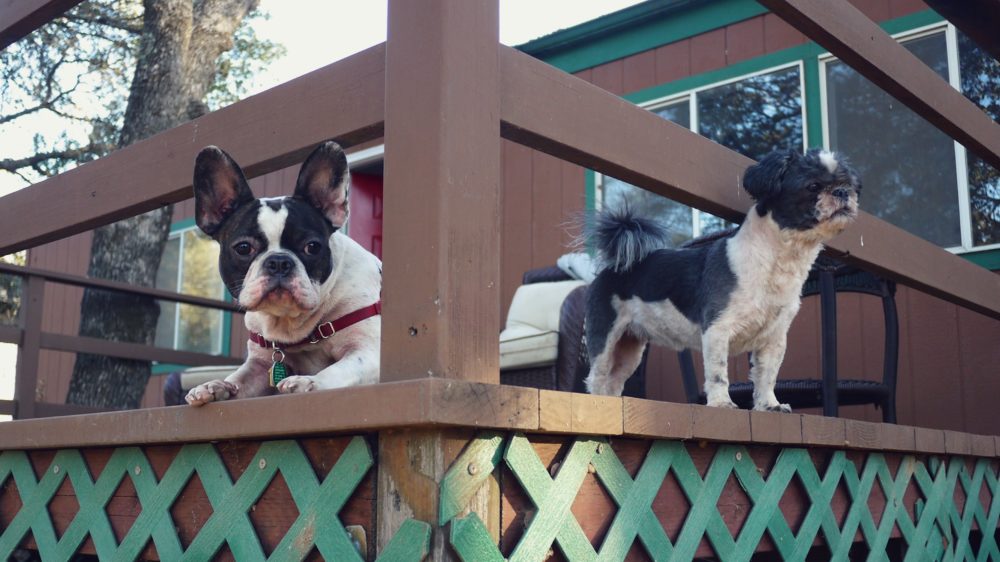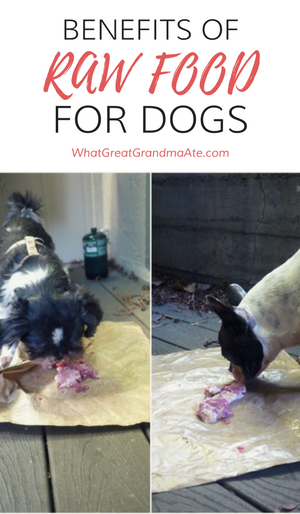This post may contain affiliate links. Please see our disclosure policy.
 Our dogs are the cutest. Not biased at all. We have a small Shih Tzu named Sally, and a Frenchie/Boston Terrier mix named Radley. Sally was C’s dog and Radley was mine, and when we decided to live together, they were forced to do so as well. I say forced because they hated each other at first, but now they are totally kosher for the most part.
Our dogs are the cutest. Not biased at all. We have a small Shih Tzu named Sally, and a Frenchie/Boston Terrier mix named Radley. Sally was C’s dog and Radley was mine, and when we decided to live together, they were forced to do so as well. I say forced because they hated each other at first, but now they are totally kosher for the most part.
From the beginning, I was extremely careful about what we were feeding them and only bought the highest quality dog foods. After all, they are family and I didn’t want to feed them kibble filled with unnecessary ingredients. Sally has always been a super healthy dog, but Radley came with various digestive problems, as well as skin allergies that made her scratch herself to the point of bleeding. We had to put a shirt on her to keep her from scratching herself so much, no joke. I hated slash loved it, because that’s just how I generally feel about dogs in shirts.
It wasn’t until we moved to California and settled a bit that I started doing some extensive research on raw feeding for dogs, and finally decided to go for it. Dogs, like humans, used to live in the wild, and exclusively ate raw meats, bones, and organs, and very little vegetables or fruits. Their systems aren’t evolved to process grains, corn, food colorings, and other weird fillers that are in commercial dog foods. Their digestive tracts are actually exactly the same as wolves. By feeding them a diet that is the closest to what their ancestors ate, they can thrive in their optimal health. Our dogs eat only meat for the most part, and some vegetables and fruits as treats occasionally.
After doing this for several months now, here are some things I learned:
1. Radley’s allergy is much more manageable, and Sally’s coat is ridiculously shiny. Radley used to be on monthly allergy shots, which was supposed to keep her symptoms at bay. It didn’t work that great, however, and we still had to keep a shirt on her to prevent her from scratching. Ever since going raw, I took her off of the shots and she no longer needs to wear a shirt. She still scratches sometimes, but it’s nowhere near as bad as it used to be. She seems much healthier now and so does Sally.
We used to free-feed Sally, meaning we left her food out and she ate it as she pleased throughout the day. It was sad how unenthusiastic she was about her food. These days, she actually looks forward to her morning feeding time (even whining for it) and finishes everything in one sitting. Since going raw, Sally’s hair looks and feels silky and shiny.
2. Not all dogs can eat the same meats and the same cuts. It is important to start slow when starting raw. I began feeding them just chicken for about 2 weeks, and then branched out to other meats like turkey, beef and eggs. It’s important to include bones and organ meats, but not too much. However, as you experiment with different cuts and meats, you’ll find that your dog can handle certain proteins better than others. For example, Radley can handle chicken and turkey skins much better than Sally. Sally seems to do really well on ground beef. I tend to feed them what works best for each dog, but still try to keep other proteins in the rotation so they get nutrients from a variety of meats.
3. Raw bones are totally fine. When I tell people what I feed my dogs, one of the first things I get asked about is, “Won’t they choke on the bones?” Raw bones are absolutely safe for dogs and they are soft enough to bend and be digested easily. It’s the cooked bones that you should ALWAYS avoid feeding. If your dog scarfs down food (like Radley), be sure to supervise the dog during feeding time to make sure everything goes okay. I haven’t had a problem with my dogs so far.
4. They are calmer. There seems to be a misconception that feeding dogs raw will make them more aggressive. This is the exact opposite of what happens. Since pure meat doesn’t contain carbs and fillers that can turn to sugar like kibble, dogs tend have calmer attitudes after they transition to raw. Also, their urge to chew or bite is taken care of with eating raw bones.
5. Less poop, less gas. Let’s get real. You’ll find out how your dog’s digestion is going during their walks. Once the dogs start eating raw, they are utilizing most of the food as fuel since it doesn’t contain fillers that their bodies feel the need to get rid of. This means less #2 when they go outside (or more, depending on if the protein is right for them or not). I’ll take any excuse to not have to pick up their sh*t as much, so I love it. Also, for anyone who owns a French Bulldog, you probably know what stinky gas bombs those cuties are. Radley used to clear the room instantly. These days, her stink problem has been reduced significantly and she seems to be digesting much better.
6. It’s more time consuming to prepare. It’s true. Buying and preparing raw meats will take longer than just scooping kibble into a bowl. Once your dog adjusts to eating raw though, it’s totally fine to feed them just once a day which makes it much more manageable. And once you start seeing the positive differences it’s making in your dog, it’s so worth it. After all, don’t you want your furry best friend to live a long healthy life? I’m still in denial and expect our dogs to live forever so I don’t have this concern. But I still want them to be the healthiest as they can be.
7. The price is comparable to high quality kibble. Just like humans, it’s important to feed our dogs high quality meats, preferably organic and grass-fed. If you feel that it’s too expensive to feed them this way, feeding them conventional raw is still better than kibble so I suggest you try it out. I also do it from time to time in a pinch. For us, we tend to buy quality meats in bulk when they are on sale. We also invested in a cow share so our dogs eat a bit of that too. If you can, it’s much more cost-effective to buy the whole animal rather than cuts. I buy a whole chicken from Trader Joe’s (they have free range, organic chicken for cheap!) and hack it up into pieces. Whatever bones are left over, I use it for bone broth.
If you want to start feeding your dogs raw, this guide was super helpful for me so I suggest you start there. I’m also happy to answer any questions you may have. However, if the thought of it all is still daunting to you, I still suggest you feed them high quality kibble for their optimal health. A great resource to find out what brand is the best is: http://www.dogfoodadvisor.com/.








I love your recipes.
I’ve followed the Leto diet from the keto pet sanctuary for years. I made your jerky treat recipe and my boy loves it!
That’s wonderful!!
I like the sound of the treats and having someone to talk to also is a big help. I started raw feeding my dog Kodi as his toilet was runny and yellow I was worried, but once I changed to raw his toilet is alot better. He has his bad days,but we will get there. Thanks Rosalind from Scunthorpe UK.
I’m just starting my American Eskimo 10 mo pup on raw food. Your blog is most encouraging and I’m hoping she will stop chewing grass and sticks if she is busy chewing chicken wings which is what I’m starting with. Keep the recipes and tips coming. Thanks